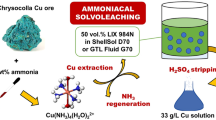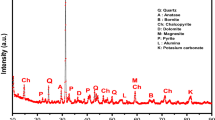Abstract
Purpose
Millions of cubic meters of sediments are dredged every year in the world. About 10–20% on weight basis of this material is contaminated by organic and/or inorganic pollutants. This work presents the laboratory tests performed to study a system for the remediation and reuse of mercury-contaminated sediments. The treatment is based on a cement-based granulation step (solidification/stabilization (S/S)), followed by a thermal process under vacuum during which volatile and semi-volatile compounds are removed. The experiments focused on: (1) cement hydration reactions; (2) pollutant removal efficiencies; and (3) leaching behavior, in relation to temperature and duration of the thermal process. Mercury speciation was also investigated.
Materials and methods
Dredged at the marine harbor of Augusta (SR, Italy), the sediments used in the experiments were highly polluted by mercury (200 mg kg−1 dry weight (d.w.)). The recipe applied in the S/S step was based on the particle size distribution of the resulting granulates. An indirectly–heated batch system operated under vacuum (2.6 ± 1.3 103 Pa) at: (1) 150°C for 16 h; (2) 200°C for 6 h; (3) 250°C for 4 h; or (4) 280°C for 4 h. X-ray diffraction spectroscopy and scanning electron microscopy were used to study cement hydration reactions. Total mercury concentration and leaching tests were carried out to assess the effects of the different treatment conditions.
Results and discussion
The best results were obtained by treating the granulate at 250°C for 4 h. Under these conditions, mercury final concentration was 49 mg kg−1 d.w., resulting in a removal efficiency of 63% referred to the granular material before thermal treatment, and 75% referred to the sediment. The concentrations measured in the leachate were compatible with the Italian requirements for reuse, with some exceptions (pH, chlorides, nickel, copper, and COD) ascribed to the specific nature of the sediment. Mercury speciation analyses pointed out changes after both the treatment steps.
Conclusions
The final granulates accomplish most Italian requirements for reuse, even though an improvement in the S/S step or an additional washing step would help for the exceptions mentioned above. Different reuse options in civil engineering (e.g., filling material, road material, concrete aggregates, etc.) will be evaluated also taking into consideration the mechanical properties. Further studies will be carried out to assess the long-term leaching behavior and leaching under different pH conditions.






Similar content being viewed by others
References
Amoroso MJ et al (2009) Management, Treatment and Reuse of Contaminated Sediments of the Venice Lagoon, RemTech 2009, Ferrara
APHA (2005) Standard Methods for the Examination of Water and Wastewater, 21st Edition. Total cyanide after distillation, 4500-CN- C
ASTM (2008) Annual book of ASTM standards. ASTM International, Philadelphia
Batchelor B (2006) Overview of waste stabilization with cement. Waste Manage 26:689–698
Bhatnagar A, Johnson CA (2004) Studies on the binding mechanism of metals and metalloids in cementitious matrices (chromium case studies), annual report. CEAC-ETHZ, Switzerland
Bone BD, Barnard LH, Boardman DI, Carey PJ, Hills CD, Jones HM, MacLeod CL, Tyrer M (2004) Review of scientific literature on the use of stabilization/solidification for the treatment of contaminated soil, solid waste and sludges. Environmental agency UK. Science report SC980003/SR2. pp. 343
Bonomo L, Careghini A, Dastoli S, De Propris L, Ferrari G, Gabellini M, Saponaro S (2009) Feasibility studies for the treatment and reuse of contaminated marine sediments. Environ Technol 30(8):817–823
BSI (1990) BS 812-110: Testing aggregates. Methods for determination of aggregate crushing value (ACV). British Standards Institution, London, UK
BSI (1998) EN 1097-2: Tests for mechanical and physical properties of aggregates. Methods for the determination of resistance to fragmentation. British Standards Institution, London, UK
BSI (2000a) EN 1367-1: Tests for thermal and weathering properties of aggregates. Determination of resistance to freezing and thawing. British Standards Institution, London, UK
BSI (2000b) EN 1097-6: Tests for mechanical and physical properties of aggregates. Determination of particle density and water absorption. British Standards Institution, London, UK
BSI (2002a) EN 1008 Mixing water for concrete. Specification for sampling, testing and assessing the suitability of water, including water recovered from processes in the concrete industry, as mixing water for concrete. British Standards Institution, London, UK
BSI (2002b) EN 12457-2 Characterization of waste—leaching—compliance test for leaching of granular waste materials and sludges—part 2: one stage batch test at a liquid to solid ratio of 10 l/kg for materials with particle size below 4 mm (without or with size reduction), British Standards Institution, London, UK
Buchman MF (1999) NOAA Screening Quick Reference Tables. NOAA HAZMAT Report 99-2, Seattle WA, Costal Protection and Restoration Division, National Oceanic and Atmospheric Administration. pp. 12
Cappunyns V, Swennen R (2008) The application of pHstat leaching tests to assess the pH-dependent release of trace metals from soils, sediments and waste materials. J Hazard Mater 158:185–195
CCMS (1997) Contaminated Sediments in Ports and Waterways: Cleanup Strategies and Technologies. Committee on Contaminated Marine Sediments, Marine Board, Commission on Engineering and Technology Systems, National Research Council. National Academy Press, Washington, USA
CEN (2004) CEN/TS 14429: Characterization of waste—leaching behaviour tests—influence of pH on leaching with initial acid/base addition. European Committee for Standardization, Brussels, B
CEN (2005) CEN/TS 14405: Characterization of waste—leaching behaviour tests—up-flow percolation test (under specified conditions). European Committee for Standardization, Brussels, B
Dijkstra JJ, Meeussen JCL, Comans RNJ (2004) Leaching of heavy metals from contaminated soils: an experimental and modeling study. Environ Sci Technol 38:4390–4395
Feeney RJ, Nicotri PJ, Janke DS (1998) Overview of Thermal Desorption Technology. Naval Facilities Engineering Service Center, Port Hueneme, California, CR 98.008-ENV
Ferrari et al (2009) Il Sistema Mapei HPSS per il trattamento e la decontaminazione dei sedimenti contaminati: la rada di Augusta e la Laguna di Venezia, Ecomondo 2009, Rimini
Fiore S, Zanetti MC, Ruffino B (2008) Waste characterization in steel casting and recycling opportunities in Europe. Amer J App Sci 5(5):512–518
Gabriel MC, Williamson DG (2004) Principal biogeochemical factors affecting the speciation and transport of mercury through the terrestrial environment. Environ Geochem Health 26:421–434
Germiniani E, Saponaro S, Battaglia A, Belfanti P, Napolitano G, Ferrari E (2009) Sustainability metrics and ecological footprint of different soil remedial scenarios: application to a case study. Offshore Mediterranean Conference and Exhibition
Gougar MLD, Scheetz BE, Roy DM (1996) Ettringite and C-S-H Portland cement phases for waste ion immobilization: a review. Waste Manage 16(4):295–303
Hakstege AL (2007) Description of the available technology for treatment and disposal of dredged material. In: Bortone G, Palumbo L (eds) Sustainable management of sediment resources, vol 2, Sediment and dredged material treatment. Elsevier, Amsterdam, pp 68–118
Hall M, Alperin E, Shealy S, Jones K (1997) Treatment of dredged harbor sediments by thermal desorption. In: Proceedings of National Conference on Management and Treatment of Contaminated Sediments, Cincinnati (OH), EPA/625/R-98/001. pp. 112–118
Hamer K, Hakstege P, Arevalo A (2005) Treatment and disposal of contaminated dredged sediments. In: Lens P, Grotenhuis T (eds) Soil and sediment remediation—mechanisms, technologies and applications. IWA Publishing, London, pp 345–369
ISO 15705 (2002) Water quality—determination of the chemical oxygen demand index (ST-COD) – Small-scale sealed-tube method
ISPRA (2008a) Annuario dei dati ambientali—Capitolo 15: Rischio Antropogenico. pp. 1029–1074
ISPRA (2008b) Progetto preliminare di bonifica della rada di Augusta inclusa nel sito di bonifica di interesse nazionale di Priolo—Fasi I e II—Elaborazione definitiva, BoI-Pr-SI-PR-Rada di Augusta-03.22
Lechler PJ (1999) Modern mercury contamination from historic amalgamation milling of silver-gold Ores in the Carson River, Nevada and Jordan Creek, Idaho: importance of speciation analysis in understanding the source, mobility and fate of polluted materials. In: Ebinghaus R, Turner RR, de Lacerda LD, Vasiliev O, Salomons W (eds) Mercury contaminated sites—characterization. Risk assessment and remediation. Springer, Berlin, pp 337–355
Loser C, Zehnsdorf A, Hoffmann P, Seidel H (2006) Bioleaching of heavy metal polluted sediment: influence of sediment properties (part 2). Eng Life Sci 6(4):364–371
Matschei T, Lothenbach B, Glasser FP (2007) The AFm phase in Portland cement. Cem Concr Res 37:118–130
MATT (2008) Disciplina delle operazioni di dragaggio nei siti di bonifica di interesse nazionale, ai sensi dell’art. 1, comma 996, della legge 27 dicembre 2006, n. 296. Italian Ministry for the Environment, the Land and the Sea, Decree 7 November 2008
Mulligan CN, Yong RN, Gibbs BF (2001) An evaluation of technologies for the heavy metal remediation of dredged sediments. J Hazard Mater 85:145–163
Navarro A, Canadas I, Martinez D, Rodriguez J, Mendoza JL (2009) Application of solar thermal desorption to remediation of mercury-contaminated soils. Solar Energy 83:1405–1414
Nota DJG (1958) Sediments of the western Guyana shelf, Report of Orinoco shelf expedition, 2. Mendedel, Landbomvhogedrool, Wegeningen, 58. p. 98
Obrador A, Rico MI, Alvarez JM, Novillo J (2001) Influence of thermal treatment on sequential extraction and leaching behaviour of trace metals in a contaminated sewage sludge. Bioresour Technol 76:259–264
Palumbo L (2007) Sediment management of nations in Europe. In: Bortone G, Palumbo L (eds) Sustainable management of sediment resources, vol 2, Sediment and dredged material treatment. Elsevier, Amsterdam, pp 11–58
Paria S, Yuet PK (2006) Solidification-stabilization of organic and inorganic contaminants using Portland cement: a literature review. 255 14:217–255
Rudin MJ (1996) Leaching of selenium from cement-based matrices. Waste Manage 16(4):305–311
Scanferla P, Ferrari G, Pellay R, Volpi Ghirardini A, Zanetto G, Libralato G (2009) An innovative stabilization/solidification treatment for contaminated soil remediation: demonstration project results. J Soils Sediments 9:229–236
Sparrevik M, Eek E, Grini RS (2009) The importance of sulphide binding for leaching of heavy metals from contaminated Norwegian marine sediments treated by stabilization/solidification. Environ Technol 30(8):831–840
Springer U, Klee J (1954) Prüfung der Leistungsfähigkeit von einigen wichtigeren Verfahren zur Bestimmung des Kohlemstoffs mittels Chromschwefelsäure sowie Vorschlag einer neuen Schnellmethode. Z Pflanzenernähr Dang Bodenk 64:1
Taube F, Pommer L, Larsson T, Shchukarev A, Nordin A (2008) Soil remediation—mercury speciation in soil and vapor phase during thermal treatment. Water Air Soil Pollut 193:155–163
UNI (1999) UNI 8981-2: Durability of concrete works and prefabricated elements – Criteria for obtaining the resistance to sulphate attack. Ente Nazionale Italiano di Unificazione, Milan, I
UNI (2009) UNI EN 933-1: Tests for geometrical properties of aggregates—determination of particle size distribution—sieving method. Ente Nazionale Italiano di Unificazione, Milan, I
US EPA (2005) Contaminated Sediment Remediation Guidance for Hazardous Waste Sites, EPA-540-R-05-012. NSCEP, Cincinnati, USA
US EPA (2007a) Treatment Technologies for Mercury in Soil, Waste and Water, EPA-542-R-07-003
US EPA (2007b) Treatment Technologies for Site Cleanup: Annual Status Report (Twelfth Edition), EPA-542-R-07-012. NSCEP, Cincinnati, USA
US EPA (2007c) Test Methods for Evaluating Solid Waste, Physical/Chemical Methods, SW-846. NSCEP, Cincinnati, USA
US EPA (2008) Green remediation: Incorporating Sustainable Environmental Practices into Remediation of Contaminated Sites, EPA-542-R-08-002. NSCEP, Cincinnati, USA
van der Sloot HA, Dijkstra JJ (2004) Development of horizontally standardized leaching tests for construction materials: a material based or release based approach? Identical leaching mechanisms for different materials, ECN-C-04-060
Wang Q, Kim D, Dionysiou DD, Sorial GA, Timberlake D (2004) Sources and remediation for mercury contamination in aquatic systems–a literature review. Environ Pollut 131:323–336
Author information
Authors and Affiliations
Corresponding author
Additional information
Responsible editor: Gijs D. Breedveld
Rights and permissions
About this article
Cite this article
Careghini, A., Dastoli, S., Ferrari, G. et al. Sequential solidification/stabilization and thermal process under vacuum for the treatment of mercury in sediments. J Soils Sediments 10, 1646–1656 (2010). https://doi.org/10.1007/s11368-010-0290-7
Received:
Accepted:
Published:
Issue Date:
DOI: https://doi.org/10.1007/s11368-010-0290-7




